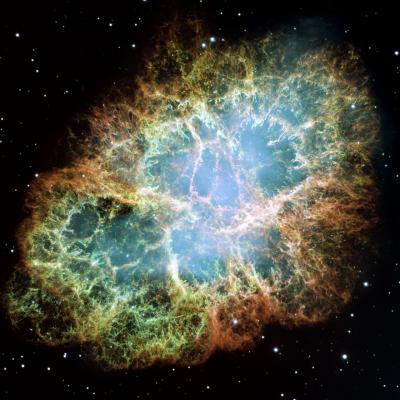The Hubble Space Telescope used its Wide Field and Planetary Camera 2 to create the image below, which is actually made up of 24 separate exposures — this is said to be the highest resolution image of the Crab Nebula ever made. Be sure to click on the image to explore it in detail. I had planned to use an intriguing Robert Forward quote for today’s entry (Saturday’s are usually a day for reflections and overviews), but this image was just too pretty to resist.
The Crab Nebula is about six light years wide, the remains of a supernova that is reliably dated at 1054 as witnessed by both Chinese and Japanese astronomers. Recall that the distance from the Sun to the primary Centauri stars is 4.3 light years and you get a sense of scale here. The filaments you’re seeing are primarily hydrogen, lit blue from within by a spinning neutron star that is the remaining core of the supernova. The neutron star emits twin beams of radiation that pulse 30 times a second due to its extreme rotational rate.
For more, click here for a fact sheet on the Crab Nebula.



From the Palomar Skies blog:
Saturday, July 4, 2009
4th of July Fireworks in 1054 A.D.
Some people are going to experience some big Independence Day fireworks shows tonight.
None of them will rival the one that the Chinese saw on July 4, 1054 A.D. They witnessed
the explosive (supernova) death of a massive star. The “guest star” that they saw was so
bright that it became visible in the daytime for 23 days and at night it cast shadows!
The remnant of this colossal event is now known as the Crab Nebula(also called as M1 and
NGC 1952).
Hundreds of years after the event was seen observations by Mt. Wilson/Palomar
astronomer Walter Baade helped to tie the nebula to the eyewitness reports from the
Chinese astronomers.
In honor of the 955th anniversary of the supernova being seen on Earth I give you 2
photos of the Crab Nebula.
Full article and an image of the Crab Nebula taken by the 200-inch Hale Telescope on
Mount Palomar circa 1959:
http://palomarskies.blogspot.com/2009/07/4th-of-july-fireworks-in-1054-ad.html
Detection of the crab pulsar with MAGIC
Authors: M. Lopez, N. Otte, M. Rissi, T. Schweizer, M. Shayduk, S. Klepser, for the MAGIC Collaboration
(Submitted on 5 Jul 2009)
Abstract: The MAGIC telescope has detected for the first time pulsed gamma-rays from the Crab pulsar in the VHE domain. The observations were performed with a newly developed trigger system that allows us to lower the energy threshold of the telescope from 55 GeV to 25 GeV.
We present a comparison of light curves measured by our experiment with the one measured by space detectors. A strong energy dependent decrease of the first peak with respect to the second peak P1/P2 could be observed.
Finally, fitting our measured data and previous measurements from EGRET we determine a turnover of the energy spectrum at 17.7 +- 2.8 (stat.) +- 5.0 (syst.) GeV, assuming an exponential cutoff. This rules out the scenario in which the gamma rays are produced in vicinity of the polar caps of the neutron star.
Comments: Contribution to the 31st ICRC, Lodz, Poland, July 2009
Subjects: High Energy Astrophysical Phenomena (astro-ph.HE); Solar and Stellar Astrophysics (astro-ph.SR)
Cite as: arXiv:0907.0832v1 [astro-ph.HE]
Submission history
From: Marcos Lopez Moya [view email]
[v1] Sun, 5 Jul 2009 20:23:37 GMT (189kb)
http://arxiv.org/abs/0907.0832